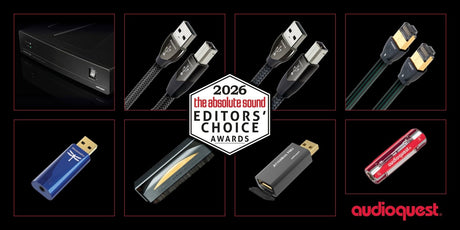
The Absolute Sound's 2026 Editors' Choice Awards: Shared Spaces
Eight AudioQuest products have received The Absolute Sound's Editors' Choice Award (Shared Spaces), featured in the November issue of TAS, available now.
Câble audio numérique
Souvent, le choix entre terminer vos câbles d'enceinte avec des fourches ou des fiches bananes dépendra de la préférence personnelle. Cependant, les bornes de liaison isolées conformes à l'UE utilisées sur certains amplificateurs de puissance rendent souvent difficile, voire impossible, de serrer les fourches avec un couple ou une pression élevés. Dans ces applications, le connecteur banane AudioQuest est le meilleur choix, et peut être le seul.
AudioQuest a mené une enquête assez exhaustive auprès des fabricants d'amplificateurs contemporains pour déterminer si les fourches ou les bananes seront les plus appropriées pour une marque et un modèle d'amplificateur donnés. Veuillez nous contacter, fournir la marque et le modèle de l'amplificateur, et nous vous répondrons quel type de connecteur est optimal.
Ici, nous recommandons généralement le connecteur U-Spade ou banane. Cependant, même s'il y a moins de poids et de pression de ce côté du câble (particulièrement pour les ensembles Bi-Câblage), il est néanmoins important de noter la conception du bornier. Si un connecteur banane ne peut pas s'insérer complètement dans la bornier, nous recommandons l'un de nos connecteurs à fourche.
Conducteurs en argent massif 0,5%
Les conducteurs solides minimisent les effets néfastes de l'interaction électrique et magnétique entre les brins. Pour les câbles numériques, dont les signaux sont d'une fréquence si élevée qu'ils se déplacent presque exclusivement à la surface du conducteur, des couches de plus en plus épaisses de plaquage en argent sont appliquées aux conducteurs en cuivre à long grain (LGC) de AudioQuest pour améliorer encore la dissipation du bruit. Placer le métal supérieur à l'extérieur du conducteur produit le plus grand bénéfice sur la performance globale—une manière extrêmement rentable de maximiser un câble numérique.
Dissipation du bruit par couche métallique
Il est facile d'obtenir une couverture de blindage à 100%. Empêcher les interférences radiofréquences capturées (RFI) de moduler la référence de masse de l'équipement nécessite la dissipation du bruit d'AQ. Les systèmes de blindage traditionnels absorbent généralement puis drainent l'énergie de bruit/RF vers la masse du composant, modulant et déformant le plan de masse "référence" critique, ce qui provoque à son tour une distorsion du signal. La dissipation du bruit "protège le blindage", absorbant et réfléchissant la plupart de cette énergie de bruit/RF avant qu'elle n'atteigne la couche attachée à la masse.
Isolation en mousse à cellules dures
L'isolation en mousse à cellules dures (HCF) assure une géométrie critique des paires de signaux. Tout matériau solide adjacent à un conducteur fait en réalité partie d'un circuit imparfait. L'isolation des fils et les matériaux des circuits imprimés absorbent tous de l'énergie. Une partie de cette énergie est stockée puis libérée sous forme de distorsion. L'isolation en mousse à cellules dures est similaire à la mousse-PE utilisée dans nos câbles Bridges & Falls plus abordables, et est injectée d'azote pour créer des poches d'air. Parce que l'azote (comme l'air) n'absorbe pas l'énergie et ne libère donc aucune énergie de ou dans le conducteur, la distorsion est réduite. De plus, la rigidité du matériau permet aux conducteurs du câble de maintenir une relation stable sur toute la longueur du câble, produisant un caractère d'impédance stable et minimisant encore la distorsion.
TERMINAISONS SOUDÉES À FROID, PLAQUÉES OR
Ce design de prise permet une connexion dépourvue de soudure, qui est une source courante de distorsion. Au lieu de la soudure, le processus utilise une technique de haute pression. Parce que les coquilles de masse sont estampées au lieu d'être usinées, le métal utilisé peut être choisi pour sa faible distorsion plutôt que pour son usinabilité.
| Caractéristiques & Performance | |
|---|---|
Dissipation du Bruit |
Couche métallique + Drainage RF directionnel
|
Forest Coax i-Pack A partir de $249.75 Voir les détails | |
|---|---|
Dissipation du Bruit |
Couche métallique + Drainage RF directionnel
|